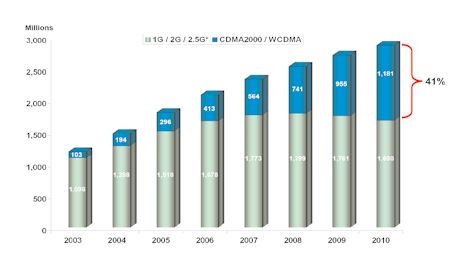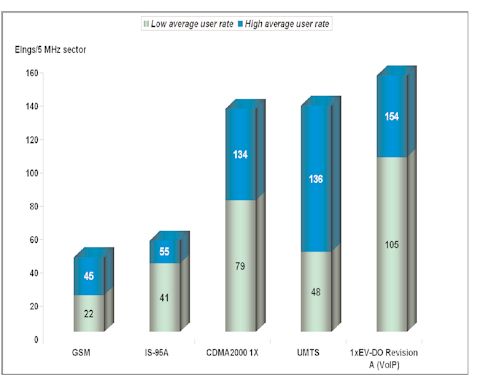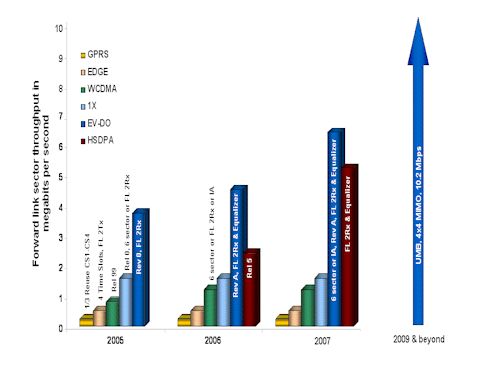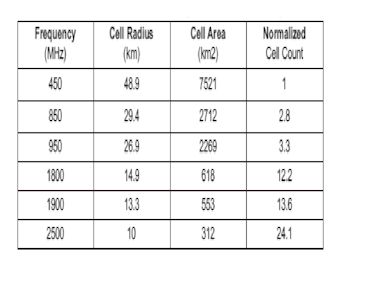|
In
2006, the wireless industry exceeded 2.7 billion users
worldwide, a major milestone. But many people – at least 4 billion
– lack access to a personal phone. People in most urban markets have
multiple wireless-service providers to choose from, but vast rural
areas in emerging markets still don’t have coverage. Bridging the
“digital divide” has become a key priority for governments.
In
order to bridge the “digital divide” many countries worldwide have
universal service projects underway and service providers are looking
for ways to deliver telephone and Internet access to underserved
markets. In most cases, wireless technologies are more economical
than wireline both for providing universal access and for operator-initiated
efforts to expand service to low-revenue areas.
Although there are a wide variety of wireless technologies available,
operators and governments increasingly are choosing 3G (CDMA2000®
and WCDMA) over 2G (GSM). 3G technologies are the most
spectrally efficient and can provide voice and true broadband access
much more economically. These are some of the reasons that the
wireless industry is steadily migrating to 3G. Analysts forecast that
the number of 2G subscribers will begin to decline in 2008 and by
2010, 3G will account for 41% of total users worldwide.
Figure
1: Worldwide 2G and 3G Subscriber Trends

Note:
1G/2G/2.5G includes AMPS, cdmaOne, GSM/GPRS/EDGE, iDEN, PDC, PHS, and
TDMA
Source: Strategy
Analytics, Worldwide Cellular User Forecasts, 2005-2010, January 2006
CDMA2000 is Best Suited for
Enabling Affordable Telecommunications
CDMA2000 technologies are leading the rapid migration to affordable 3G
services. As of January 2007, 190 operators in 84
countries have deployed or are deploying CDMA2000 networks. There are
more than 325 million CDMA2000 customers, which is
approximately 70% of the 3G market today. In developing
markets, CDMA2000 is by far more widely deployed than WCDMA. In fact,
more than 125 of the 190 CDMA2000 operators are in
developing markets.
Figure 2: CDMA2000 Deployments and
Trials Worldwide

186
1X Commercial Networks
40 1X Deployments (to be launched)
6 1X Trials
55 1xEV-DO Commercial Networks
57 1xEV-DO Deployments (to be launched)
6 1xEV-DO Trials
5 1x EV-DO Rev. A Commercial
6 1xEV-DO Rev. A Deployments (to be launched)
Source:
CDMA Development
Group, February 2007
The
family of CDMA2000 technologies that are commercially available today
include CDMA2000 1X, 1xEV-DO Rel. 0 and Rev. A.
CDMA2000 1X is a digital voice and data technology capable of
supporting up to 168 voice subscribers per sector and peak data
transmissions up to 153.8 kbps. 1X is the most widely deployed
3G technology today with 226 commercial and pre-commercial
networks and 320 million users across all continents.
-
CDMA2000 1xEV-DO Release 0 (Rel. 0) is an evolutionary
technology upgrade that is optimized to support peak download speeds
of up to 2.4 Mbps and upload speeds of up to 153.8 kbps.
It is widely used to provide enhanced data services, including
video, multimedia and broadband Internet access. Up to 112
operators have deployed or are deploying Rel. 0 and they currently
serve 55 million users.
-
CDMA2000 1xEV-DO Revision A (Rev. A) is an enhanced version of
Rel. 0 and is the most advanced 3G technology commercially
available today. With its ability to support significantly
higher peak data rates (3.1 Mbps on the downlink and 1.8
Mbps on the uplink), carrier-grade Quality of Service (QoS) and
low latency (below 50 milliseconds) on an IP radio network, Rev. A
enables operators to extend IP throughout the radio access and core
network and to offer delay-sensitive, concurrent and symmetrically-oriented
applications, such as Voice over Internet Protocol (VoIP), video
telephony and push-to-talk services on the same packet network.
CDMA2000 is ideal for developing countries because it can very
economically provide telephone, Internet access and advanced data
services in both densely-populated urban centers and sparsely-populated
rural regions. The technology has also leapfrogged other wireless
technologies in the migration to next-generation all-IP capabilities
to offer converged next-generation telecommunication services in the
future.
By
deploying CDMA2000 1X, an operator can take advantage of the high-voice
capacity and broad range of low-cost devices to deliver affordable,
high-quality voice services even to the most price-sensitive consumers.
By complementing 1X with CDMA2000 1xEV-DO Rev. A, an operator can
offer broadband Internet, advanced multimedia messaging, customized
enterprise data applications and delay-sensitive services such as VoIP.
Once VoIP-enabled Rev. A devices become widely available in 2009,
operators will have the option to migrate from 1X circuit switch voice
to the more robust and cost efficient all-IP delivery of voice and
data. This will help enable the convergence of telecommunications,
entertainment and information technology in the palm of a user’s hand.
CDMA2000
Advantages
When
selecting a wireless technology, operators and governments should
evaluate the following key commercial and technical considerations:
-
Reliable, clear, secure and ubiquitous access to carrier-grade
voice services.
-
High-speed
broadband data and Internet access, increasingly important
for supporting business, health, education and safety within
emerging markets.
-
Coverage, capacity and scalability of the wireless network to
cover sparsely-populated rural areas and to easily and cost-effectively
add network capacity in densely-populated urban areas.
-
Network Flexibility to support a wide variety of environments
and installations (fixed and full mobility; urban and rural areas,
outdoor and indoor coverage, contiguous and non-contiguous coverage,
IP-based and circuit-switched core network interfaces, etc.).
-
Favorable Economics enabled through a reduced Total Cost of
Ownership (TCO), which includes capex, opex, and handsets priced
below $35USD.
-
Wide
selection of affordable devices (from entry-level phones to
broadband-enabled PC laptops and Internet access modems) from a
large selection of suppliers who benefit from large economies of
scale.
-
Clearly
defined, long-term technology evolution roadmap with backward
compatibility to ensure the preservation of previous investments.
-
Availability of the technology
within various frequency allocations to enable network
deployment flexibility, roaming and economies of scope.
-
Proven technology to ensure that it is capable of
providing what the users want and expect. An enhanced user
experience will increase customer satisfaction, revenue per user and
loyalty, while reducing churn.
All of these aspects
are well covered by the family of CDMA2000 technologies, as follows:
Figure
3: Voice Capacity per Sector

Source:
Various and Signals Research Group, LLC
-
High-speed broadband, low latency and enhanced quality of service
of CDMA2000 1xEVDO Rev. A., make it ideal for broadband access to
the Internet and bandwidth-intensive applications (streaming
multimedia, distance learning, telemedicine and VoIP).
Figure 4: Forward Link Data
Throughputs

Notes:
1. Full buffer,
physical layer throughput with 100% of subscribers using latest
technology. Actual gains would depend on handset penetration
2. 6 Sector sites:
cover the same area as 3-sector sites. Capacity quoted for 2 adjacent
sectors or 120 Degree arc. IA = Intelligent Antenna.
-
Flexible design for both mobile and fixed services, using
wideband or narrowband bandwidths, with ubiquitous or non-contiguous
coverage, expanding the network as the demand for services grows and
incrementally adding more bandwidth as needed, thanks to the smaller
1.25 MHz channel size.
-
Economics of CDMA2000 is more favorable than most any other
wireless technologies. In the long run, CDMA2000 @ 800 MHz or 450
MHz has a competitive TCO advantage over GSM and WCDMA. CDMA2000
offers a 26% cost savings over GSM/UMTS/HSDPA @ 2100 MHz and
a 12-23% cost savings over GSM/UMTS @ 900 MHz.
-
Device availability with close to 1600 CDMA2000 device
models on the market today, offered by 89 suppliers, with
prices of CDMA2000 1X entry-level handsets approaching GSM price
levels. (Entry-level 3G CDMA2000 1X handsets from multiple suppliers
are available in the range of $25-40 USD.)
-
Available for use in a wide range of frequency bands (450,
800, 1700, 1900 and 2100 MHz). The lower frequencies, such as 450
MHz and 800 MHz are especially well-suited for covering sparsely
populated rural areas because the radio signals in these
bands travel farther. As a result, fewer base stations and less
capital and operating investments are required to serve a large area.
Figure 5: How Frequency Affects
Coverage

Sources:
ANATEL and Lucent Technologies
Conclusion
Over
the past several years, wireless has emerged as the favored means of
providing universal access to telephony and broadband data services in
emerging markets. Of all the wireless technologies currently
available and scheduled for release within the next two years,
CDMA2000 offers superior performance and economics, enabling the
affordable delivery of carrier-grade voice, multimedia messaging,
Internet access and a wide variety of other broadband data services to
emerging markets. The technology’s benefits include affordable voice
and true broadband speeds, ample device selection, an ecosystem with
significant economies of scale and scope, and substantial cost savings
in capital and operating investments.
Mr. Celedonio von Wuthenau
Regional Director for Latin America
CDMA Development Group, Inc.
|

